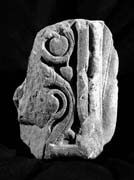Select a site alphabetically from the choices shown in the box below. Alternatively, browse sculptural examples using the Forward/Back buttons.
Chapters for this volume, along with copies of original in-text images, are available here.
Object type: Fragment of cross-shaft [1]
Measurements: H. 13.3 cm (5.25 in); W. 5.7 cm (2.25 in); D. 10.2 cm (4 in)
Stone type: Sandstone, reddened, medium to coarse grained, hard quartz cemented, slightly micaceous. Middle Coal Measures Group, Carboniferous. [G.L.]
Plate numbers in printed volume: Ills. 215-7
Corpus volume reference: Vol 8 p. 140-1
(There may be more views or larger images available for this item. Click on the thumbnail image to view.)
There is a roll moulding between the two surviving faces.
A (broad): The face or panel had a narrow border, now surviving only on the left and lower edges. Only the lower left corner of the panel survives. This contains the lower part of a robed figure, exceptionally deeply modelled (it stands about an inch above the edge moulding). There is a fine double fold of drapery entirely on the side of this raised figure. The drapery on the front of the figure falls in wide ridge-like folds. An element, perhaps the lower edge of a book or hand, is visible just below the break.
B (narrow) and C (broad): Missing
D (narrow): This face had a wider inner moulding but it terminates at the same point as the panel on face A. The side moulding is rolled, the lower border is flat. Within the panel is a deeply modelled plant-scroll, its stem standing directly on the lower edge of the panel. It is a simple scroll with a median-incised stem. The stem divides into alternate-facing volutes at a ridged node. The lower volute terminates in a plain, perhaps round, leaf, like the upper volute, and there is a small pendant berry bunch or round leaf in the spandrel.
This piece has an unusual depth of modelling, and is a very accomplished piece of carving. Lang (in Lang and Wrathmell 1997, 378–9) saw it as by a different hand from any other at the site, but believed it must have been part of a shaft or cross-head with modelled busts and portrait figures, like Dewsbury 1–5 and 9. Dewsbury. The modelling is even deeper than on the Breedon Virgin panel (Cramp 1977, fig. 58a). He compared it in terms of quality to Otley 1 and Little Ouseburn 5 in west Yorkshire (Ills. 552–63, 530–5), Easby 1 in north Yorkshire (Lang 2001, ills. 193–212), and Halton, Lancashire (Collingwood 1927, fig. 92). Lang also noted that its plant-scroll has a plain round leaf (or berry) in the centre of the volute, as on the small inscribed cross-arm Dewsbury 10 (Ill. 233), though it has other details which are different. It is clear that the scroll starts from the base line of the panel without a root, a feature found at the start of the medallion scroll on Ledsham 2 (Ill. 476), and found also on Crofton 2 (Ills. 180–1) and the later Collingham 2D (Ill. 173). These connections imply that Dewsbury 8 was a very prestigious piece, which may have been influential over the monastic sculpture in a wide area of west Yorkshire, or at the very least that it was at the forefront in a very significant period for the development of sculpture in the West Riding monastic milieu.



